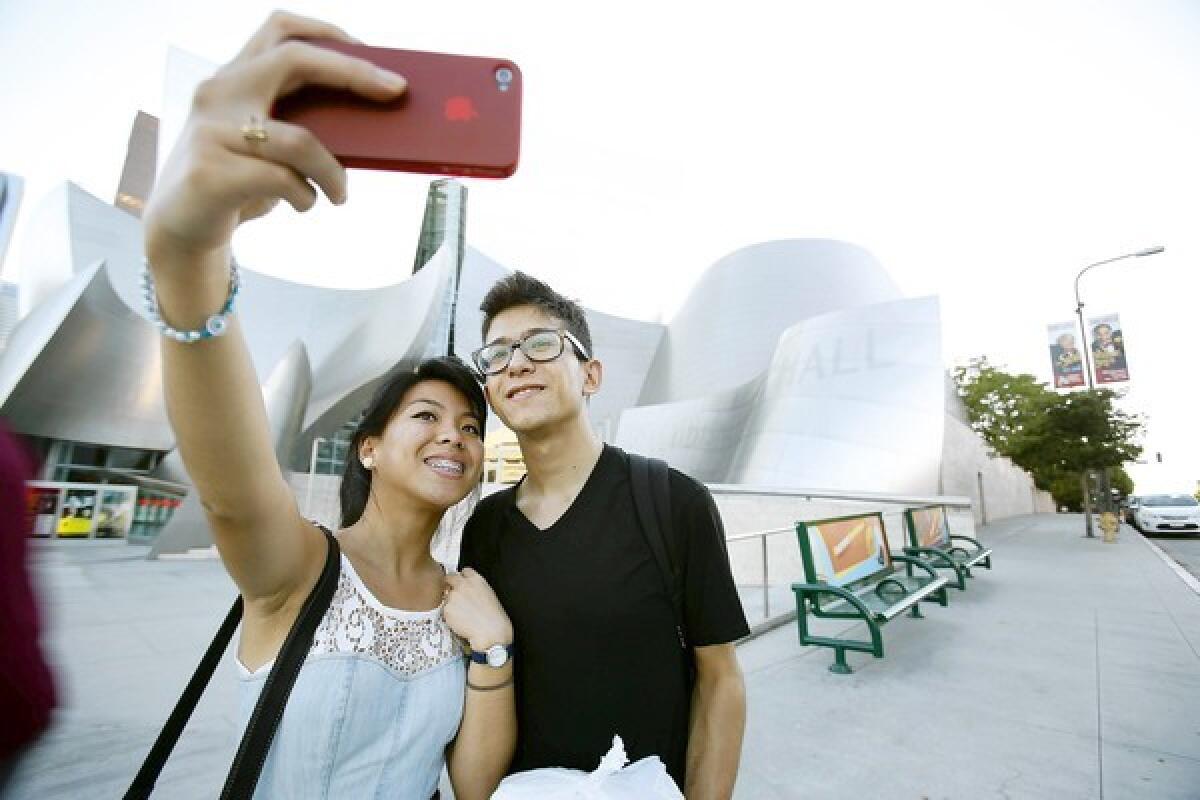Disney Hall’s architecture, not its music, lures many

They come at night for Gustavo Dudamel. They come during the day for Frank Gehry.
Not everyone visiting the Walt Disney Concert Hall during its first decade has been interested in experiencing the Los Angeles Philharmonic Orchestra, it seems.
“I’m not here for the music. I like the architecture,” said Lucian Huxley Smith, a 26-year-old writer from London.
FULL COVERAGE: Walt Disney Concert Hall at 10
Smith was with Penni Killick, 25, who works for a London literary agency. “I like music. But I’m here to see the building,” agreed Killick.
Architecture buffs Timo Kersten and Aline Jede, both from Germany, joined a dozen others for one of the free guided tours offered most days at Disney Hall.
Music Center employee Jan Hilander led the group from the Grand Avenue lobby to the second floor, called the stage level. As the visitors peered over a railing, she explained that the Douglas fir wood panels on the curving wall were designed with acoustics in mind for BP Hall, where lectures, dinners and other events are staged.
On the third-floor garden level, Hilander told of how Gehry himself drew up the geometric floral design used in the Disney Hall carpeting. The same design, called “Lillian” after original hall donor Lillian Disney, is replicated in the fabric upholstery created for the performance hall’s 2,265 seats.
PANORAMA: Inside Walt Disney Concert Hall
Lillian Disney, widow of Walt Disney, launched the campaign to build the 3.6-acre hall and garden on a former Bunker Hill parking lot used by jurors at the civil courthouse. She gave the project its first $50 million in 1987. It took an additional $274 million to actually design and build Disney Hall, with fundraising taking 12 years and construction taking four, Hilander explained to the group.
Donors are thanked with discreet signage inside and outside the hall. The names of major ones are spelled out in steel lettering embedded in laser-cut industrial felt that lines one interior wall, she said. Donors’ names are also incorporated in outdoor courtyards.
The building is illuminated by a combination of natural light and subtle electric lighting, she said. The backlighted Walt Disney Concert Hall sign near the hall’s main entrance at Grand Avenue and 1st Street is part of the signage that the Bruce Mau graphics firm created using a new typographic font called “Frank” in honor of Gehry. The designers said their goal was to have lettering that was “equally at home with philharmonic formal and downtown funky.”
Leading the group into the performance hall, Hilander told of how Gehry even designed the look of the concert organ’s curved wooden pipes, built by German organ maker Caspar Glatter-Götz in collaboration with tonal designer Manuel Rosales.
TIMELINE: Walt Disney Hall through the years
The soundproof concert hall has a mere 2% echo, she explained. “The acoustics here, designed by Yasuhisa Toyota of Nagata Acoustics, are the best in the world.”
As the tour continued, Hilander led the group to an area where the building’s structural skeleton has been left uncovered by the building’s 6,800 steel panels. “There are no right angles here,” she explained. She pointed to a rain gutter “lip” which keeps water from sheeting down the curving side of the building during stormy weather.
“The most frequently asked question is, ‘How is this building washed?’” she added. A good rain is the easiest way, although maintenance crews use ladders, cherry pickers and an automated rooftop device for cleaning. Fingerprint-removal is a frequent task in high-traffic areas.
Fingerprints are not a problem at a sunny fifth-floor overlook that serves up a stunning view of downtown’s high-rises, however. That’s because a sign at the edge of the observation area warns visitors not to touch the building’s hot steel surface.
INTERACTIVE: Disney Hall inside and out
The hour-long tour ends where it started, in the Grand Avenue lobby near the Lobby Bar, made of glistening layers of sanded blue glass
Tour participants Kersten and Jede were impressed by what they’d seen.
“This looks pretty amazing from the outside,” said Kersten, a 24-year-old computer science student from Munich. “The amazing part is how people worked together to build this. They’ve brought this building to life.”
Jede, 22, a biotech student from Dresden, said she took the tour because she was fascinated by the hall’s exterior look. “I wouldn’t say I’m a fan” of classical music, she acknowledged.
Hilander, who has led public tours of the hall for five years, said she often encounters visitors – including groups of architects – who are drawn by Gehry’s iconic design, not a love for symphonic music.
“Many people taking the tour don’t know this is the home of the L.A. Philharmonic,” she said.
More to Read
The biggest entertainment stories
Get our big stories about Hollywood, film, television, music, arts, culture and more right in your inbox as soon as they publish.
You may occasionally receive promotional content from the Los Angeles Times.











